Does Chlorine Make Your Hair Lighter?
Updated on
This post may contain affiliate links. As an Amazon Associate, we may earn from qualifying purchases.
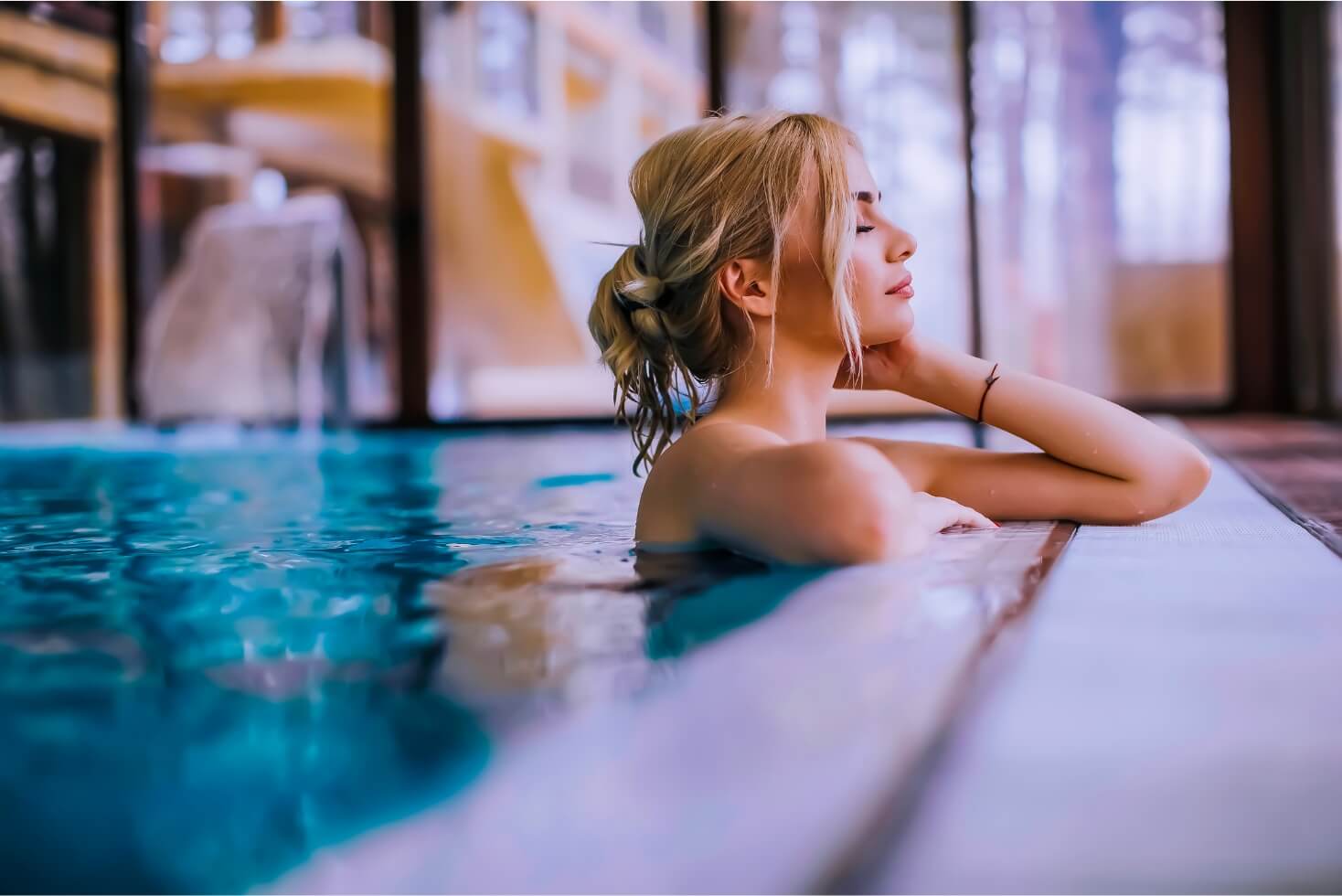
According to research published by the Department of Dermatology of Tokyo, chlorine in swimming pool water oxidizes and degenerates melanosomes, the melanin-containing organelles in the hair. [1]
Although the research was performed on elite swimmers, who have prolonged chlorine exposure compared to recreational swimmers, there is enough evidence to suggest that chlorine can make the hair lighter through the release of reactive Hypochlorous acids that are known to have a bleaching effect on the hair. [2]
So what does it mean to you if you’re an occasional swimmer?
Should you be worried about the effects of chlorine if you’re just taking the occasional dip in the pool while on vacation?
Read on to find out how chlorine affects the hair and what you should do to protect your natural hair color, color-treated hair, and highlights.
Table of Contents
Chlorine Does Make Hair Lighter
Yes, chlorine does make hair lighter by oxidizing and breaking down melanin-containing organelles (melanosomes) that give hair its color. Chlorine can also draw out artificial hair dye pigments to fade hair color rapidly when exposed for a long period.
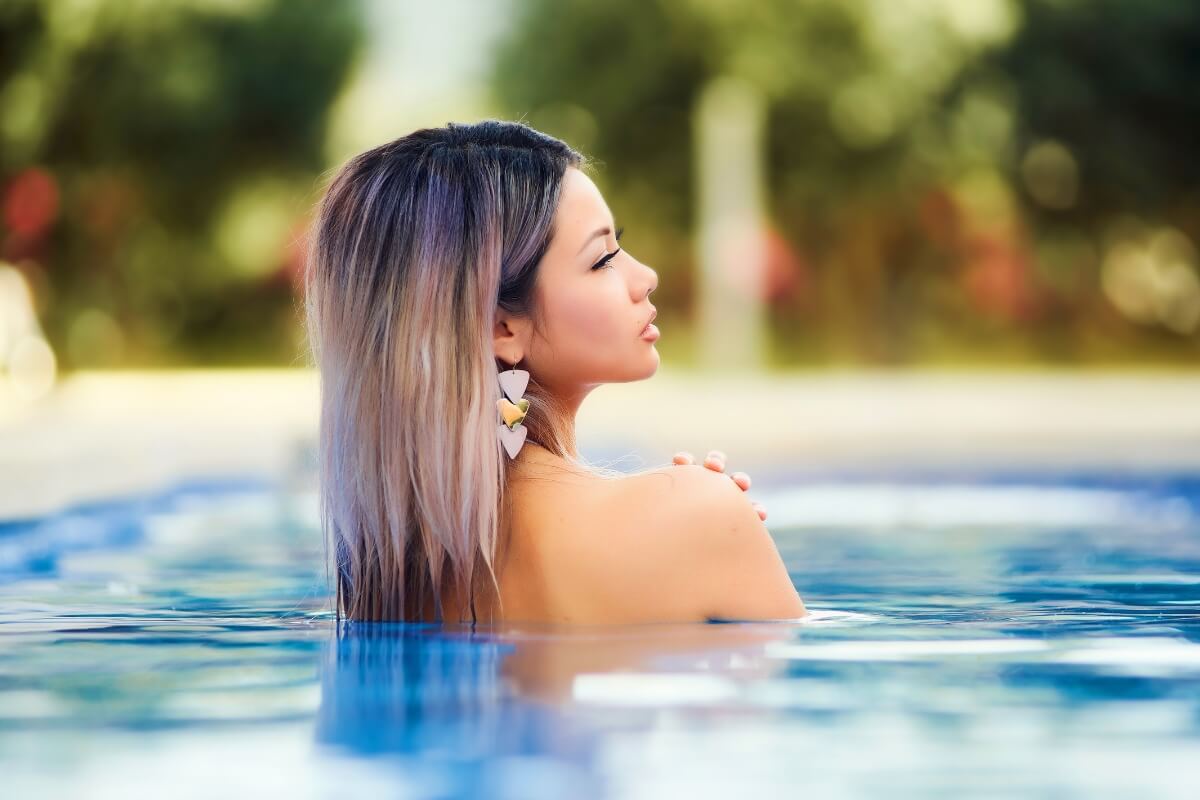
The mechanism behind chlorine’s stripping or bleaching action is the release of reactive hypochlorous acids (HClO). Hypochlorous acids are weak and unstable acids that work as the primary disinfection agents of chlorine. They are formed when chlorine is dissolved in water, creating a combination of hydrogen and oxygen atoms that release free radicals (oxidizers).
Oxidizers, also known as reactive oxygen species, generate oxidative stress that leads to loss of hair color [4]. Oxidative stress is also the primary reason why hair turns gray. It’s called the “free radical theory of graying.” [5]
To further back up this claim, a study performed on virgin dark-brown hair, virgin blonde hair, and bleached hair showed significant changes in hair color saturation when exposed to chlorine at pH 5 for 4 hours. In all three hair samples, yellowness and lightness increased, resulting in the dark brown hair becoming redder and bleached hair becoming less red. [3]
When chlorine interacts with melanin, its particles stick to the melanin and lift it off, leaving only keratin behind (in its pure underlying pigments). If your hair is color-treated, it’s even easier to dislodge the color pigments once the chemicals permeate through the cuticles.
Regardless if it’s your natural hair color or dyed pigments, prolonged exposure to chlorine will strip the color to make your hair lighter.
Different hair types may respond differently to chlorine. For instance, a hair type with higher porosity (open cuticles) will be more affected by chlorine as the chemical can easily infiltrate the cuticle layer. Bleached hair, for example, is highly porous due to the chemical processing it has undergone. Therefore, expect chlorine particles to easily diffuse through the open cuticle cells to fade or alter your hair color.
Can Chlorine Turn Your Hair Green?
Green hair is commonly linked to swimmers’ hair. Many are convinced that chlorine is the culprit behind green hair, but there’s more to the issue. Even though chlorine is a yellowish-green gas, it does not alter your hair color to green on its own.
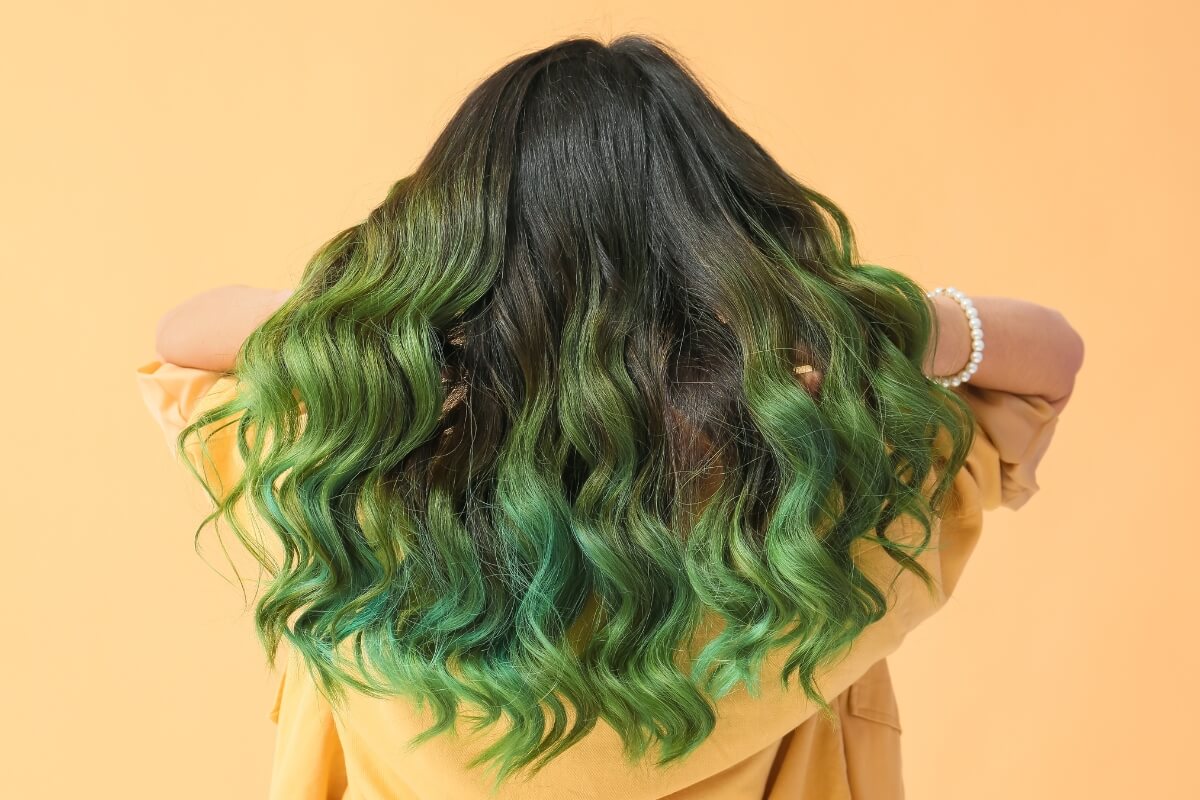
Due to the presence of other elements in chlorinated pool water, like copper, your hair can turn green, a rather pale green color.
So, just to clear the air around chlorine and green hair: chlorine by itself won’t transform your hair color to green – chlorine oxidizes copper in the water, which then creates a patina or layer of green.
Related: How to remove green tones from hair.The Effects of Chlorine on Hair
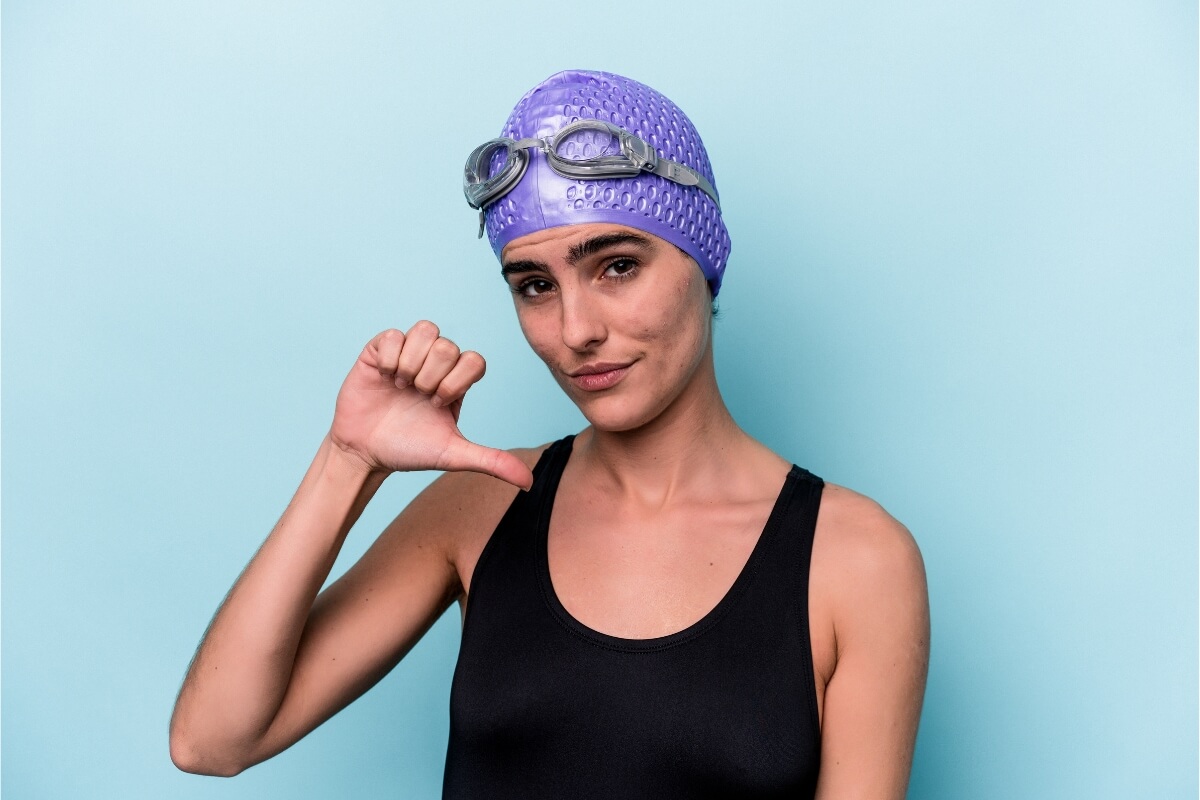
Chlorine is a chemical in the form of a yellow-green gas (at room temperature) commonly used in swimming pools, hot tubs, and spas to kill bacteria in the water and prevent contamination. However, when chlorine comes into contact with hair, it can cause numerous adverse effects.
Chlorine Strips Natural Oils from the Hair
Every hair strand is layered with sebum, a naturally occurring lipid layer that lubricates and protects the strand from external aggressors and damage. Sebum is also present on the scalp, where it is produced by the sebaceous glands, adding a layer of acidity to prevent bacterial growth.
In short: Sebum is the ultimate natural conditioner for your hair and your scalp. A disbalance in sebum production can throw off the pH of your scalp and leave your hair dry, brittle, and vulnerable to damage from external elements.
When chlorine bonds with the hair, it oxidizes the lipid layer, stripping it away and cleaving off essential keratin proteins that make up the hair strand. This causes the hair to become dry, brittle, and prone to breakage.
Chlorine Weakens the Keratin in Hair
According to a study by the University of Missouri-Columbia published in 1987, chlorine can affect the tensile properties of the hair, causing structural damage from halogenation in keratin fibers. [6]
The study also demonstrates how chlorination can alter surface morphology by breaking peptide bonds and disulfide bonds in keratin fibers. Although the tests were not performed directly in human hair, the keratin fibers used were very similar.
With all the structural damage that chlorine causes to the hair, it’s no surprise that chlorine can also degrade natural or artificial color in the hair.
How to Keep Your Hair Safe from Chlorine?
From swim caps to shampoos formulated for post-swimming hair to special swimmer-safe conditioners, there are many ways to prevent chlorine-damaged hair.
Here are a few you should try:
Saturate Your Hair with Water Before Dipping In
Saturate your hair with pure water before you get in the pool. Rinse it well, and rinse thoroughly. Cosmetologists like Kendra Aarhus compare our hair to sponges. She also elaborates that once a sponge is full of water, it absorbs no more, claiming that the same happens to our hair. Before you go into the pool, ensure you give your hair enough clean tap water, so it doesn’t need a refill of pool water.
Use a Swimmer’s Leave-In Conditioner
To protect your hair from absorbing chlorine, drench it with a leave-in conditioner. A good leave-in conditioner will act as a shield to protect hair and prevent chlorine from penetrating. Use it as your regular conditioner – apply to wet hair, and lather it nicely all the way to the ends.
Recommended: Best leave-in conditioners for swimmers.Use a Swim Cap
If you’re a competitive swimmer, swim caps are probably an essential part of your swimming gear. They protect the hair from chlorination and keep them in place.
Although a swim cap won’t keep your hair dry or away from chlorine, it does minimize contact with chlorinated waters.
Recommended: Best swim caps to protect hair from chlorinated pools.Always Take a Post-Swim Shower
After you’re done swimming, if you have the option, rinse off your hair immediately. Using clean tap water on your hair to remove chlorine is the most hassle-free method of ridding your locks of chlorine. Moreover, using an after-swim shampoo will help speed up the process of eliminating copper chloride from your hair.
Avoid Using Blow Dryers After Swimming
Blow-drying your hair immediately after swimming can make matters worse, as the heat will open up the cuticles and allow more chlorine particles to enter the cortex. Leave your hair to air dry naturally instead.
Malibu C Swimmers Shampoo Set

As a strong oxidizer, chlorine boasts potent bleaching properties that can lift natural and artificial colors in the hair.
You may not see a substantial difference if you’re a recreational swimmer, but you can suffer hair color alteration if you’re a frequent pool user.
Can you prevent the occurrence? Yes, you can!
Before dipping in the pool, make sure you protect your hair. Use a swim cap and a leave-in conditioner, and remember to wash your hair with pure water straight after swimming.
References & Citations
- Nanko H, Mutoh Y, Atsumi R, Kobayashi Y, Ikeda M, Yoshikawa N, Fukuda S, Kawa Y, Mizoguchi M. Hair-discoloration of Japanese elite swimmers. J Dermatol. 2000 Oct;27(10):625-34. doi: 10.1111/j.1346-8138.2000.tb02243.x. PMID: 11092265.
Retrieved on 02 Dec 2022. - An oxyacid of chlorine (HClO) containing monovalent chlorine that acts as an oxidizing or reducing agent.
https://www.researchgate.net/topic/Hypochlorous-Acid
Retrieved on 02 Dec 2022. - Pires-Oliveira, Rafael & Joekes, Ines. (2010). Hair color damages caused by exposure to chlorinated water in the presence of ultraviolet radiation.
Retrieved on 02 Dec 2022. - Trüeb RM. Oxidative stress in ageing of hair. Int J Trichology. 2009 Jan;1(1):6-14. doi: 10.4103/0974-7753.51923. PMID: 20805969; PMCID: PMC2929555.
Retrieved on 02 Dec 2022. - Arck PC, Overall R, Spatz K, Liezman C, Handjiski B, Klapp BF, Birch-Machin MA, Peters EM. Towards a “free radical theory of graying”: melanocyte apoptosis in the aging human hair follicle is an indicator of oxidative stress induced tissue damage. FASEB J. 2006 Jul;20(9):1567-9. doi: 10.1096/fj.05-4039fje. Epub 2006 May 24. PMID: 16723385.
Retrieved on 02 Dec 2022. - N.B. FAIR and B.S. GUPTA, University of Missouri-Columbia, Columbia, MO 65211 (N.B.F.), and North Carolina State University, Raleigh, NC 27695-8301 (B.S.G.).
https://silo.tips/download/changes-in-properties-of-keratin-fibers
Retrieved on 02 Dec 2022.
About the Author
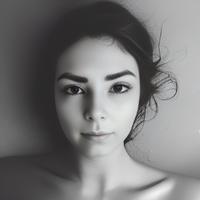 Tina Moretti
Tina MorettiTina Moretti, a passionate hair care enthusiast with over a decade of expertise, dedicates herself to empowering women with proven hair care advice. Recognized for her hands-on experience and trusted guidance, Tina turns every strand into a statement of beauty and confidence.